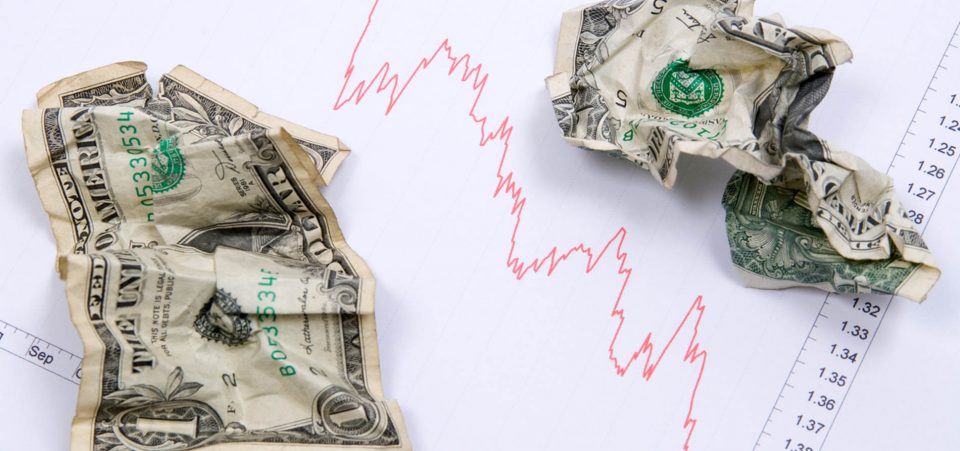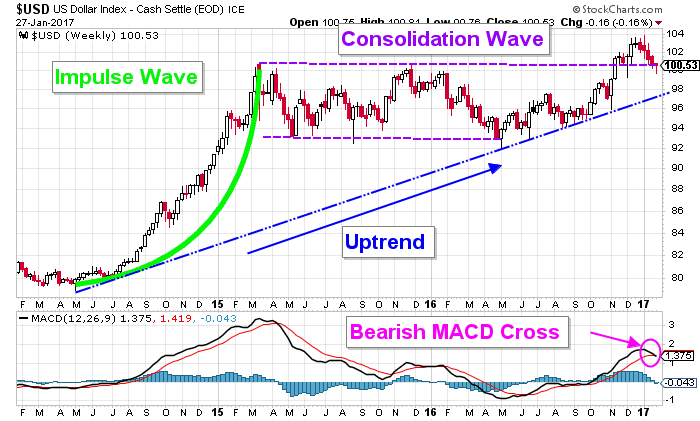U.S. Dollar: Mission Critical
There is something about the mighty king U.S. dollar that just doesn’t sit right with us, and these feelings of discontent are stemming from the price action on the U.S. dollar chart. The dollar is at a critical turning point and, if a rally doesn’t ensue, it could set off an avalanche of U.S. dollar selling. This would reinvigorate the notion of a U.S. dollar crash.
The fundamental backdrop presents two opposing arguments. The U.S. Federal Reserve is standing by its word to raise interest rates, and this supports the notion of a stronger U.S. dollar. At the same time, the new federal government administration led by President Donald Trump has expressed its concerns about a strong dollar, and this supports the notion of the arrival of a weaker U.S. dollar.
The technical backdrop still supports a higher U.S. dollar, but that view is now in danger of averting. If this bullish backdrop reverses, it could potentially set off a barrage of selling, catching many off guard.
The following price chart illustrates the pivotal point at which the U.S. dollar now sits.
Chart courtesy of StockCharts.com
The chart of the U.S. dollar index illustrates that the rally that began in the summer of 2015 has been sustained by healthy and constructive price action.
Healthy and constructive price action is defined by a particular wave structure. This wave structure entails impulse waves that advance the price, and consolidation waves that unwind any overbought conditions and set up the next impulse wave.
The rally off of the summer 2015 lows that is highlighted in green in the above chart constitutes the impulse wave, and the sideways trading range highlighted in purple constitutes the consolidation wave.
In November 2016,, the U.S. dollar exited the consolidation wave in an upward direction, which suggested that a new impulse wave was set to develop. The U.S. dollar is now testing this consolidation from above. This type of price action is not uncommon, and it serves to reaffirm that the break above resistance is legitimate.
If the U.S. dollar fails to hold this level, then the break above resistance was illegitimate, and would be deemed a failure. Failed signals are never to be ignored, because they have a tendency to generate powerful and violent moves.
The resulting power and violence from a failed signal is associated with the notion that, when signals fail, traders must exit or unwind their positions as quickly as possible. This creates the scenario in which everyone who was bullish—based on the idea that a new impulse leg was in development—is now running to the exits at the same time and, as result, a tidal wave of selling ensues.
This could be the precursor to a U.S. dollar crash.
The moving average convergence/divergence (MACD) indicator in the lower panel of the above chart is about to generate a bearish momentum signal. MACD is a simple and effective trend-following momentum indicator. Signal-line crossings are used to distinguish between bullish momentum and bearish momentum.
The bearish cross that was just generated indicates that bearish momentum has now overwhelmed any bullish momentum and, a result, the path of least resistance is lower. This reinforces the possibility that a failed signal might be on the horizon.
The indicator that will—without a doubt—confirm my suspicions about a failed signal is the uptrend line. The uptrend line defines the bullish trend in the U.S. dollar that began in summer 2015, and it is created by connecting the troughs on the chart. Last year, the dollar tested this trend on numerous occasions, and the price found support each and every time. If the U.S. dollar falls below this trend line, it will confirm that a failed signal has occurred, and a significant drop is expected, even perhaps a U.S. dollar crash.
Bottom Line on the U.S. Dollar
The U.S. dollar index is at a critical juncture that will require higher prices in order to retain its bullish stature. Failure to do so could set off a wave of selling. When the consensus surrounding the direction of the U.S dollar is so tilted to one side, there is an inherent danger that, when the tide begins to turn, investors who find themselves on the wrong side of the trade could stampede for the exits. This would constitute the perfect ingredients for a U.S. dollar crash.







